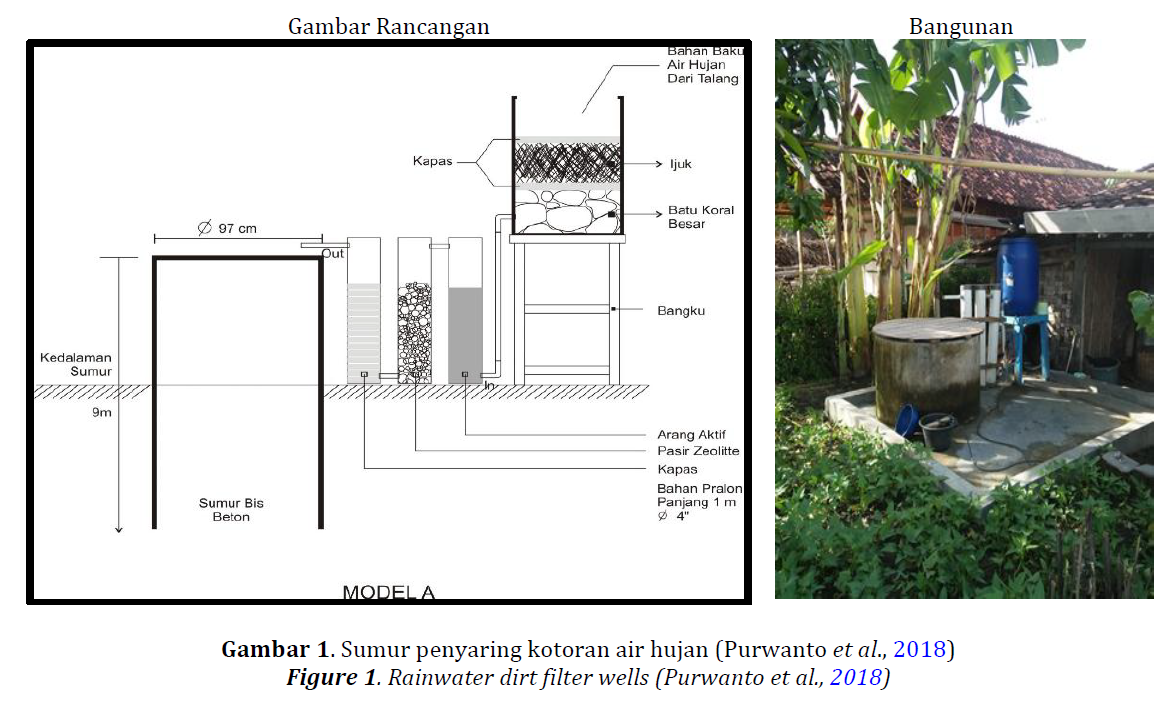Financial Analysis of Rain Water Harvesting Tools in Pamor Hamlet, Banjardowo Village, Kradenan Sub District, Grobogan District

Downloads
The drought that occurs in the dry season is one of the hydrometeorological disasters. A total of 82 villages of 12 districts in Grobogan, Central Java, experience a clean water crisis due to drought because the well, as their main source of water, is likely to go dry. Therefore, a solution is needed to anticipate the water shortage. The aims of this paper is to analyze financially the water harvesting building which can be used as a reference for the community. The research was conducted in Pamor Hamlet, Banjardowo Village, Kradenan District, Grobogan Regency. The method used was to build the rainwater harvesting engineering models, namely (a) recycling tools for washing and bathing, (b) dirt filter wells, (c) three meters depth infiltration wells (1 well and 2 wells), and (d) five meters deep infiltration wells (1 well and 2 wells). Data collection was done by conducting a survey of the community. The data collected were the costs required for the construction of the rainwater harvesting equipment, maintenance, electricity, supporting materials, etc. The income was approached with replacement costs if the community buys water during the dry season. The financial analyses of NPV, IRR, BCR, and PP were employed. The results showed several feasible models to be applied, namely recycling equipment for washing and bathing, dirt filtering equipment, three meters deep infiltration wells (1 piece) and a depth of 5 meters (1 piece). This model is very good to be adopted by the community because it is easy and has minimal costs.
Adi, H. P. (2011). Kondisi dan konsep penanggulangan bencana kekeringan di Jawa Tengah. In Seminar Nasional Mitigasi dan Ketahanan Bencana 26 Juli 2011, UNISSULA Semarang (pp. 1–10).
Adiningsih, E. S. (2014). Tinjauan metode deteksi parameter kekeringan berbasis data penginderaan jauh. In Prosiding Seminar Nasional Penginderaan Jauh 2014 (pp. 210–220).
Badan Pusat Statistik Kabupaten Grobogan. (2018). Kecamatan Kradenan dalam angka 2018. BPS.
BNPB. (2016). Ancaman hidrometeorologi semakin meningkat. Gema BNPB Ketangguhan Bangsa Dalam Menghadapi Bencana, 7(1), 4–8.
Chriestedy P, R., & Choiron, M. (2017). Analisis kelayakan pengadaan air bersih untuk mengatasi kekeringan di Dusun Calok (Studi kasus HIPPAM Dusun Calok, Arjasa). In Prosiding Seminar Nasional Kewirausahaan dan Pengabdian Masyarakat 2017.
Detik. (2018). Kekeringan meluas, 89 desa di Grobogan krisis air bersih. Detik Online. Retrieved from https://news.detik.com/berita-jawa-tengah/d-4197211/kekeringan-meluas-89-desa-di-grobogan-krisis-air-bersih.
Ermiati. (2010). Analisis kelayakan dan kendala pengembangan usahatani jahe putih kecil di Kabupaten Sumedang (Studi Kasus Kecamatan Cimalaka Kabupaten Sumedang). Buletin Penelitian Tanaman Rempah dan Obat, 21(1), 80–92.
Ha, P. E., Susilo, G. E., & Wahono, E. P. (2018). Perencanaan sistem pemanenan air hujan skala rumah tangga di Korea Selatan. Jurnal Rekayasa Sipil dan Desain, 6(1). 25-31.
Harsoyo, B. (2010). Teknik pemanenan air hujan (Rain Water Harvesting) sebagai alternatif upaya penyelamatan sumberdaya air. Jurnal Sains dan Teknologi Modifikasi Cuaca, 11(2), 29–39.
Hermon, D. (2018). Mitigasi bencana hidrometeorologi : banjir, longsor, ekologi, degradasi lahan, puting beliung, kekeringan. Padang : UNP Press.
Kharisma, R., Yudono, A., & Lopa, R. T. (2016). Pemanfaatan rainwater harvesting (pemanenan air hujan) berbasis low impact development (studi kasus : kawasan pendidikan FT-UH Gowa). In Prosiding Temu Ilmiah IPLBI 2016 (pp. 89–96).
Kompas. (2018). Memasuki kemarau, 82 desa di Grobogan alami krisis air bersih. Kompas Online. Retrieved from https://regional.kompas.com/read/2018/07/26/14545491/memasuki-kemarau-82-desa-di- grobogan-alami- krisis-air-bersih.
Kusumawardani, D. (2011). Valuasi ekonomi air bersih di Kota Surabaya. Majalah Ekonomi, 216–229.
Maulidah, S., & Pratiwi, D. E. (2010). Analisis kelayakan finansial usahatani anggur Prabu Bestari. AGRISE Agricultural Socio-Economics Journal, 10(3), 213–225.
Muryani, C., Sarwono, & Hastuti, D. (2016). Adaptasi masyarakat terhadap bencana kekeringan di Kabupaten Grobogan, Jawa Tengah. In Prosiding Seminar Nasional Geografi UMS 2016. Upaya Pengurangan Risiko Bencana Terkait Perubahan Iklim (pp. 348–355).
Nurrohmah, H., & Nurjani, E. (2017). Kajian kekeringan meteorologis menggunakan Standardized Precipitation Index (SPI) di Provinsi Jawa Tengah. Geomedia, 15(1), 1–15.
Purwaningsih, A. N. K. (2014). Analisis kerentanan kekeringan di Sub DAS Opak Hulu pasca erupsi Merapi tahun 2010 menggunakan Sistem Informasi Geografis (Skripsi). Yogyakarta : Universitas Negeri Yogyakarta.
Purwanto, Riyanto, H. D., Supangat, A. B., Fallah, F., Hermawan, A., & Subandrio, B. (2016). Teknik dan kelembagaan konservasi air di wilayah kering. Laporan Hasil Penelitian. Balai Penelitian dan Pengembangan Teknologi Pengelolaan DAS. (Tidak dipublikasikan).
Purwanto, Riyanto, H. D., Supangat, A. B., Fallah, F., Jariyah, N. A., Hastanti, B. W., … Hermawan, A. (2018). Rencana Operasional Pengembangan (ROPg) : Teknik dan kelembagaan konservasi air dan kelembagaan konservasi air wilayah kering. Laporan Hasil Penelitian. Balai Penelitian dan Pengembangan Teknologi Pengelolaan DAS. (Tidak dipublikasikan).
Purwanto, & Supangat, A. B. (2017). Perilaku konsumsi air pada musim kemarau di Dusun Pamor, Kabupaten Grobogan. Jurnal Penelitian Sosial Dan Ekonomi Kehutanan, 14(3), 157–169.
Purwanto, W. A. (2017). Kearifan lokal masyarakat Desa Segoromulyo Kecamatan Pamotan Kabupaten Rembang dalam menghadapi bencana kekeringan (Skripsi). Universitas Negeri Semarang.
Salim, A. G. (2016). Pemanenan air hujan : salah satu upaya mengkonservasi air. Wana Tropika, 9(1), 25–30.
Sallata, M. K. (2014). Paradigma konservasi tanah dan air : hubungannya kerusakan lingkungan. Info Teknis Eboni, 11(2), 81–94.
Setiawan, M. I., Iskandar, T., & Budiyanto, H. (2015). Pengembangan bangunan air inflated structure sebagai fasilitas tanggap bencana. In Prosiding Seminar Nasional Teknologi 2015 (Senatek 2015) “Peningkatan Daya Saing Teknologi Nasional Menyongsong MEA 2015” 17 Januari 2015 (pp. 1–10).
Surmaini, E. (2016). Pemantauan dan peringatan dini kekeringan pertanian di Indonesia. Jurnal Sumberdaya Lahan, 10(1), 37–50.
Sutrisno, E., Siregar, Y. I., & Nofrizal. (2016). Pengembangan sistem pemanenan air hujan untuk penyediaan air bersih di Selatpanjang Riau. Jurnal Dinamika Lingkungan Indonesia, 3(1), 1–8.
Wawasan. (2018). Kekeringan, warga Grobogan andalkan droping air. Wawasan Online. Retrieved from https://www.wawasan.co/news/detail/5330/kekeringan-warga- grobogan-andalkan-droping-air.
Wulandari, W. S., Darusman, D., Kusmana, C., & Widiatmaka. (2015). Kajian finansial pengembangan biodisel kemiri sunan (Reuealis trisperma (Blanco) airy Shaw) pada lahan tersedia di Jawa Barat. Jurnal Penelitian Sosial dan Ekonomi Kehutanan, 12(1), 31–42.
Zuber, A. (2011). Kemiskinan masyarakat pedesaan: studi kasus di Desa Sanggang, Sukoharjo. Jurnal Sosiologi Dilema Dialektika Masyarakat, 27(2), 95–110. Retrieved from https://eprints.uns.ac.id/12349/1/Publikasi_Jurnal32.pdf.




